When you go out a bike during the winter, sooner or later you end up finding two types of cyclists. You may even be one of them.
On the one hand there are those who before leaving home are put on a layer of clothes after another as if they were climbing Everest: a couple of t -shirts underneath, jersey, vest, winter jacket, another jacket just in case, two pairs of Gloves, knees heater, headquades for the head ... and in the jersey pocket there is no lack of a show and some thermal reinforcement shirt just in case. They are so warm that they could both go by bicycle and go out to the conquest of the South Pole.
On the other hand there are those who do not seem to care about the cold and come out with the short manga jersey, their summer culot and little else. A fine jacket in case you see or some sleeves to cover the arms at most and voila. His argument is usually that "
Then I enter heat when I go on the bike and I have everything left over".
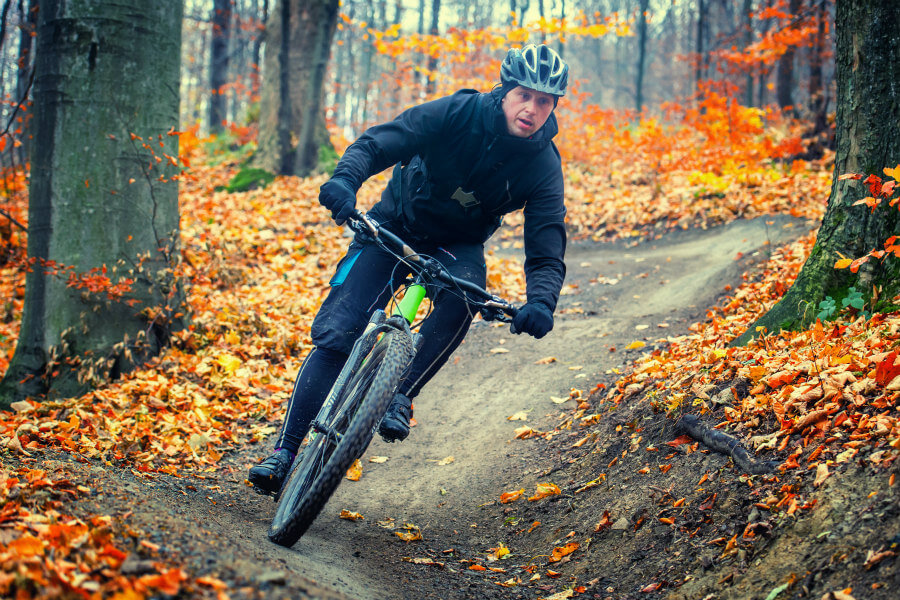
Really equipped to go by bicycle in the spring and summer months is relatively simple. It is enough with a fine and comfortable mail of short sleeve and a culot that does not make chafing.
But in winter the thing is complicated. The cold, the rain and the wind are not the best friends of the cyclist. Sometimes we can sin shortly when choosing the garments with which to go by bicycle, with the risk of contracting a cold. On other occasions we can also go from forecasts and suffer heat for wearing so many clothes on top.
[IRP posts = "3854" name = "How to prepare to go by bicycle in winter"]
How should we dress to go by bicycle during the winter months? Here are some guidelines that can be useful to equip your closet in order to continue enjoying the bicycle between November and February.
The three layers theory
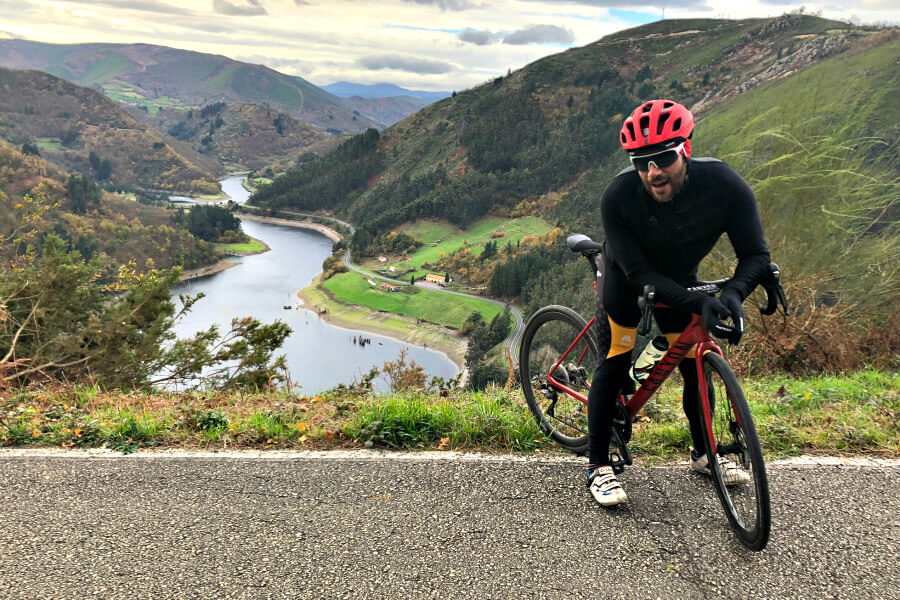
It is important that the body remains at an adequate temperature. This is easy to understand: in winter it is cold and we need to be warm.
However, there is a detail that we should not forget. In winter we not only have to protect ourselves from low temperatures, but also from moisture. Both that can come from the outside through wind or rain, and from that generated inside through sweat.
Therefore, in addition to wearing clothes that isolate and warm, it is also very important that it is breathable and that allows sweat to evaporate from the body outward.
Just as in summer the logic dictates that we go out with a traditional manga jersey and traditional culotte, there are no specific clothing standards for winter. First because cold and humidity conditions are not the same in all places. And second because we are not all as sensitive to low temperatures.
However, there is a basic recommendation that we can follow to cover the body and protect ourselves from winter inclemencies: dress by layers. When choosing what garments to put on, it is recommended to wear three layers. rmally 3 layers.
The first layer helps us create a microclimate and move away the humidity produced by the sweat of the skin. The most advisable thing is to use a thermal shirt. It can be long -sleeved or short -sleeved, depending on how comfortable we feel with one or the other and the garment we use in the second layer.
The second layer fulfills the function of retaining heat and thus avoiding temperature loss. We can use a specific winter jersey or, if we wear a long -sleeved thermal t -shirt and does not make it excessive cold, the classic summer jersey.
The third layer aims to isolate ourselves from the cold, wind and humidity from outside. We can wear a vest, a specific jacket, a window or a raincoat.
It is important that the 3 layers are able to evaporate moisture from the inside, so the clothes must be breathable. Sweat is one of the worst enemies of cycling in winter, since we can be cold if too much moisture is concentrated near the skin.
[IRP posts = "3854" name = "How to prepare to go by bicycle in winter"]
Wear specific cycling clothes, not other sports
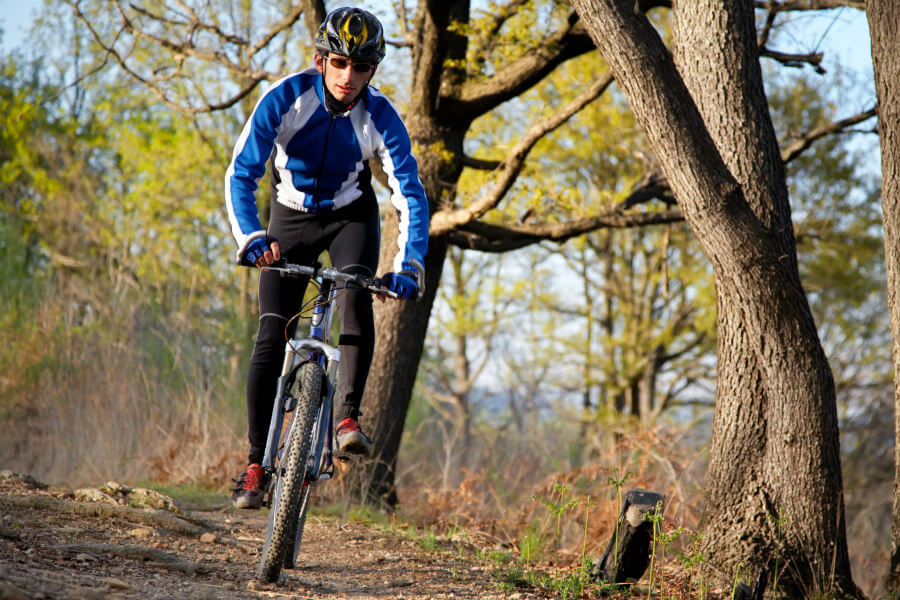
When buying clothes to wear when we go by bicycle during winter it is better not to focus on quantity, but on quality. It is not about buying a lot of clothes that shelter well, but about going out with the appropriate equipment so that we feel comfortable when we make a route or training.
It is better to acquire specific cycling clothes than multisport or other sports garments. A frequent error among fans who start in cycling is to wear jackets with neoprene or mountain to get out with the bicycle.
This clothes, although it is light and protects us from external cold and humidity, is actually designed to be used in conditions very different from pedaling on top of the bicycle. A hiker who ascends a mountain walking does not sweat the same as a cyclist who uploads a port or performs a trail route.
On the other hand, the thickness or the materials used fulfill a different function in the same garment depending on the sport for which it is designed. Neoprene, for example, is a good thermal insulator, but does not favor perspiration (except for goretex).
It should not forget that it is not just about not going cold. When you have been 3 hours on the bicycle, it is important to feel comfortable and not have the feeling that you are missing or you have any garment left over.
These are the basic garments that should not be missing in your closet if you are going out by bicycle during the winter months:
Thermal t -shirt

It is, without a doubt, the essential garment that every cyclist should carry when it comes out in winter, regardless of the practice of route or mountain. The three qualities that a thermal t -shirt for cycling should have are: to perspire, that hot the body and that does not cause chafing.
The thermal shirt acts as a second skin. These t -shirts are usually elastic and it is convenient that they fit the body well. If you choose a size that will be large, bags will be generated between your skin and the shirt and may not fulfill its function. But do not forget that it is about fitting your skin, not what you compare you, so if you wear a small size you will go very tight and uncomfortable on top of the bicycle.
Maybe you can think that for this first layer you can serve an inner t -shirt of straps or short sleeves. It may protect you from the cold, but these types of t -shirts are usually made of cotton, a material that retains more humidity than the synthetic fibers of the thermal t -shirts. This means that sweat will not go abroad, with the consequent risk of moisture cooling.
It is advisable to have a fine and a thicker thermal shirt. Or a long sleeve and a short sleeve or technical t -t -shirt of straps. In this way you can combine them with the jersey depending on the cold it makes: the fine with a thicker jersey, or the thick long sleeve with the short -sleeved jersey. We insist: It is important that it be of quality, because it is in contact with our skin.
Winter jersey or sleeves?
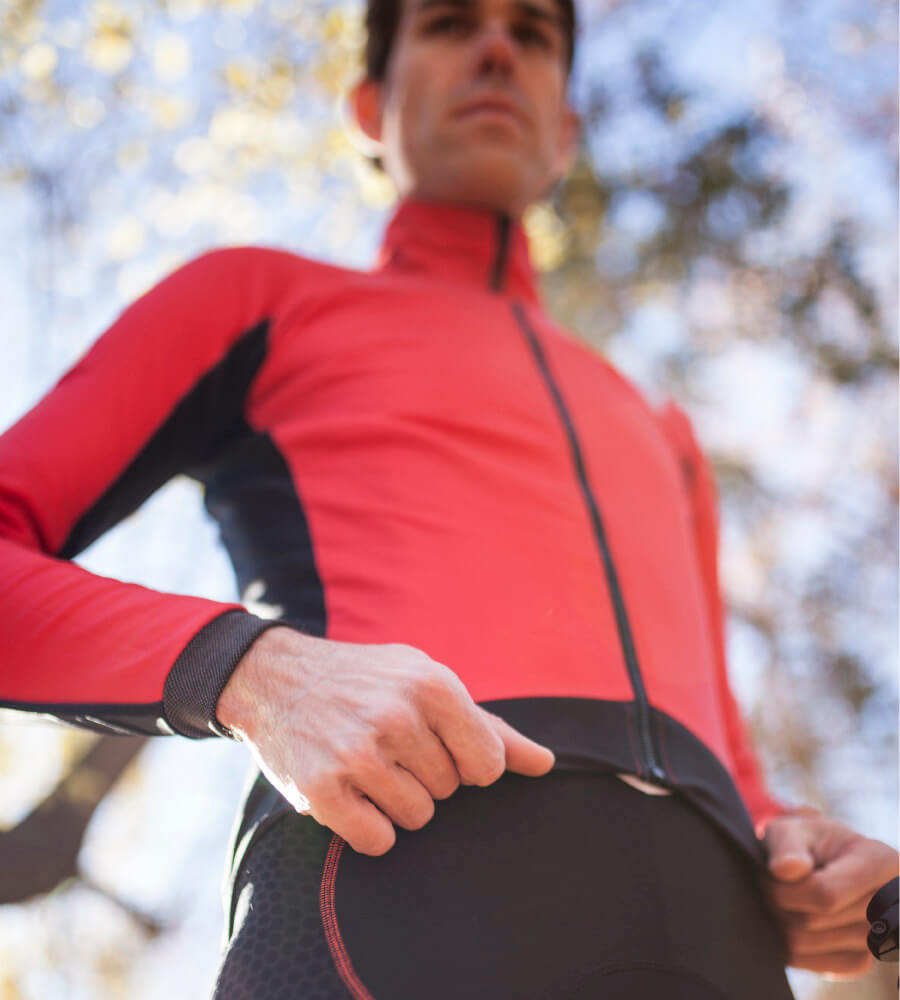
A recurring doubt to get in winter is the jersey. Is it better to buy a long -sleeved long -sleeved winter jersey or enough to acquire some sleeves and continue using the usual?
Here it will depend on each one, the sensations you have, the cold you feel, on the area where you go by bicycle. It is not the same to make a route in the month of January for the towns of black architecture inside Guadalajara at 8 degrees below zero than on the coast of Cádiz to 12 degrees.
The important thing is that it is a jersey. That is, it is a garment to make cycling, not an old sweater or a running sweatshirt.
Some cyclists prefer to wear fine jersey and sleeves to protect the arms. Others feel more comfortable with a long -sleeved thermal shirt under the short manga jersey. But most have a long -sleeved jersey, somewhat thicker for the days when the cold is more strongly. It never hurts to have a winter jersey in the closet.
Jacket, vest and showers
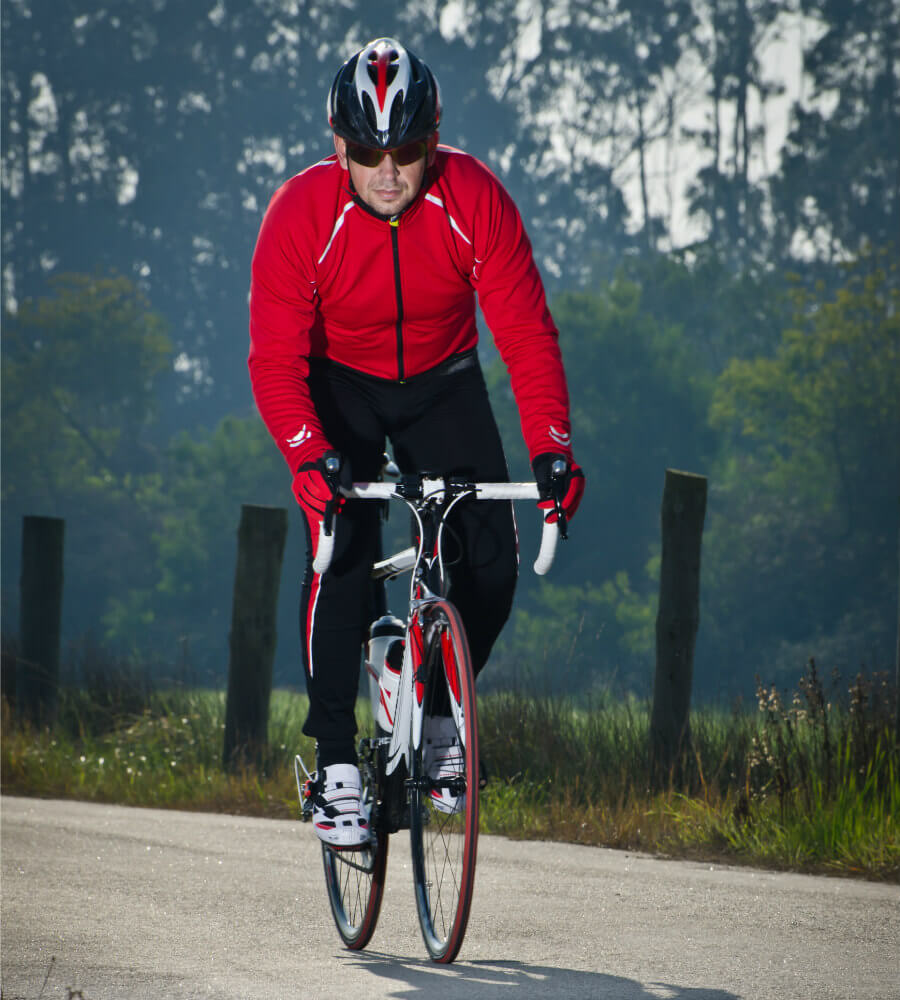
The third layer is the one that generates the most when it comes to bicycle. Do we put the vest? Better a cycling jacket for winter? Do we take out the raincoat? When deciding to take into account a maxim that always applies: decide what you decide, more than once you will have the feeling that you have chosen badly.
Sometimes we sin excessively by putting the vest and the raincoat and ended up suffering a sauna effect while we climb a mountain port. On other occasions we leave the jacket at home because it seems that the sun is out and we end up missing it.
In the end everything will depend on the sensations you have and the time you do. If it rains or threatens rain, it never hurts to throw the raincoat or windwalk in the backpack. If she refreshes but the sky is clear and with a sun, it may be enough with the vest. If the thermometer marks temperatures below zero, the jacket is essential.
If you wear a vest, it is essential to wear sleeves unless you have a long -sleeved jersey or a long -sleeved thermal t -shirt.
In any case, this third layer of clothing is the easiest to add or remove. If you go in the middle of a route you should never stop to take off or wear a thermal shirt or a jersey. However, it is very easy to get a raincoat or a vest out of the pocket of the jersey. Or take off your jacket and save it in your backpack.
In winter the temperature usually vary from one week to another and even from one day to another. That is why it is advisable to have the three garments: vest, cycling jacket and raincoat. As with the thermal shirt and the jersey, buy material that is specific for cycling. A hunting raincoat or a neoprene jacket for mountaineering are not easy to store in the jersey pocket and hinder the evaporation of sweat.
Long culot or short culot with meshes?
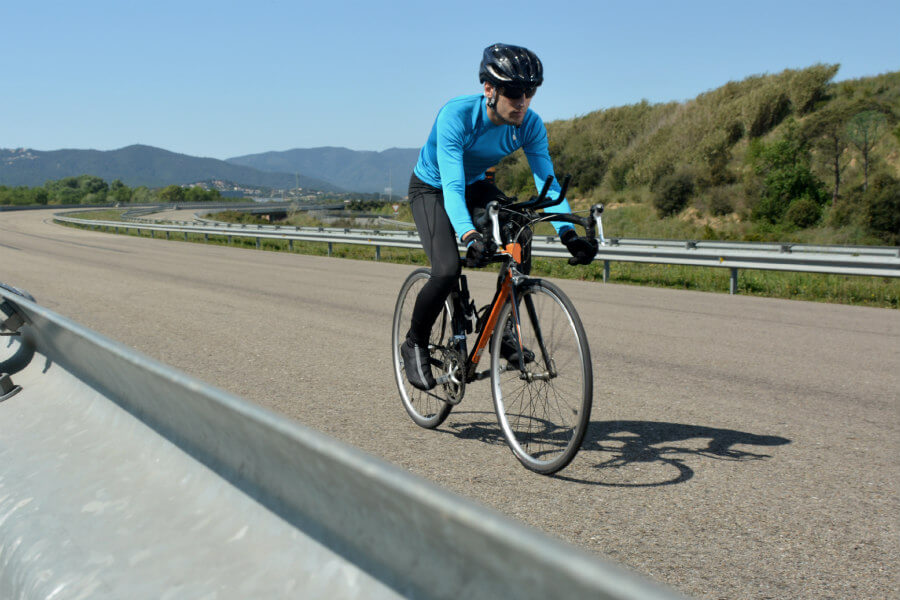
Once the body issue is resolved, let's go to the legs. Is it essential to use a long winter culot? Can you get by bicycle with the short culot and legs in the air? Is it better to invest in some perneras?
As with the top of the body, in terms of legs, two factors must be taken into account when buying specific clothing to practice cycling in winter.
On the one hand the climatic conditions that we are going to find in the two or three months of cold. If we live in Burgos and we want to leave an average of 2 or 3 days a week, we are probably profitable to spend money on a good winter long jersey. But if we live in Malaga or Huelva, we may only have one day throughout the winter where we will need it, so we can manage with quality perneras.
Our sensations are also important. As in the running, there are people who are really uncomfortable to play sports with long pants. In any case, keep in mind that the thermal sensation that is experienced in the legs when you have been over the bicycle with a short jersey in winter is not precisely pleasant.
Except that you live in an area where winters are soft and the temperature does not usually drop from 10 degrees, it is recommended to bike with the legs covered. The three most common ways to do so are the following:
Use perneras and knee heater
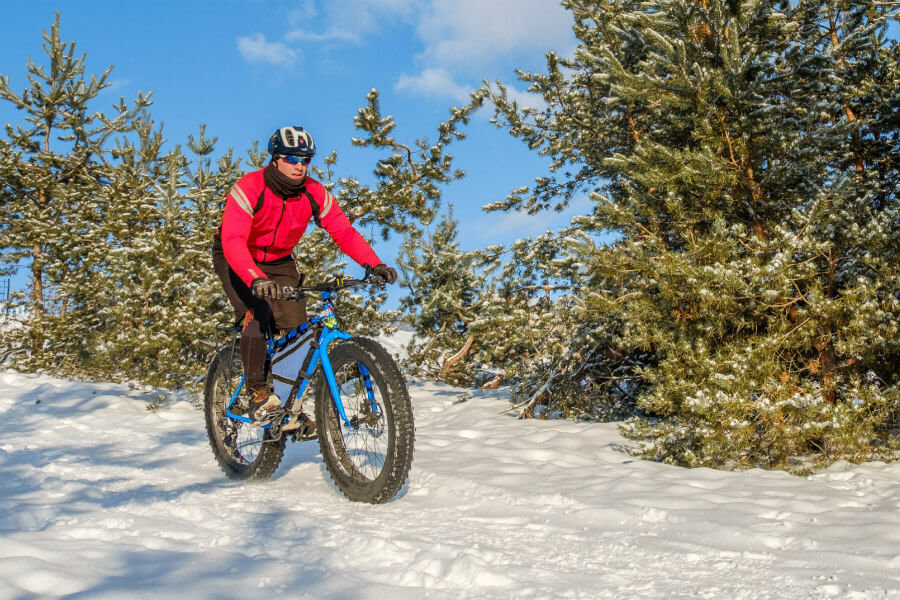
In the same way that for the arms we can use sleeves, for the legs there are perneras, which can be complemented with knee heaters. The latter are a kind of knee that are adjusted in the joint.
An advantage of this option is that you do not need to buy a specific long winter jersey and it will be cheaper. However, it is important that the perneras are of quality to fit the leg comfortably without moving or excessively compressed. It is also important that they are of a specific material to practice cycling. If you use cotton perneras, sweat will not evaporate correctly. The sensation of pedaling with the legs soaked in sweat, especially in the rear of the knee, is not pleasant.
As a disadvantage, most perneras are designed to cover the skin, but not to completely isolate from the cold outside. That is, in the fresh days of autumn they are very practical, but in December at 3 degrees and with dry wind any of the following two options is preferable.
Put long meshes under the short culot
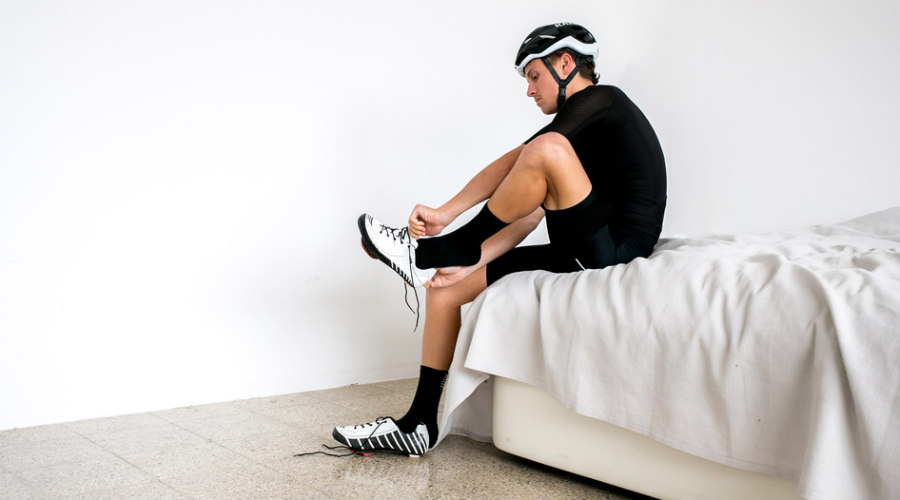
Like some cyclists, they prefer to wear a long -sleeved thermal shirt under the jersey, there are also those that choose to wear long meshes under the short culot.
As in the previous case, the main advantage is that we do not need to buy a long culot and we can continue to use the same short colotes that we dress in spring and summer. It will always be cheaper to acquire inner meshes than a winter culot.
This option can be more practical in winter than the use of perneras and/or knee heaters. However, like everything else, it is not exempt from disadvantages. The main one is comfort. When you make long routes or exits it is not recommended to wear under the culot to avoid the rubbing of the seams. If you put some meshes, no matter how thin they are, you are already adding a textile layer between your skin and the culot, so friction can occur. In addition, it is not practical in the event that you have to stop to go to the service.
Use a long winter culot
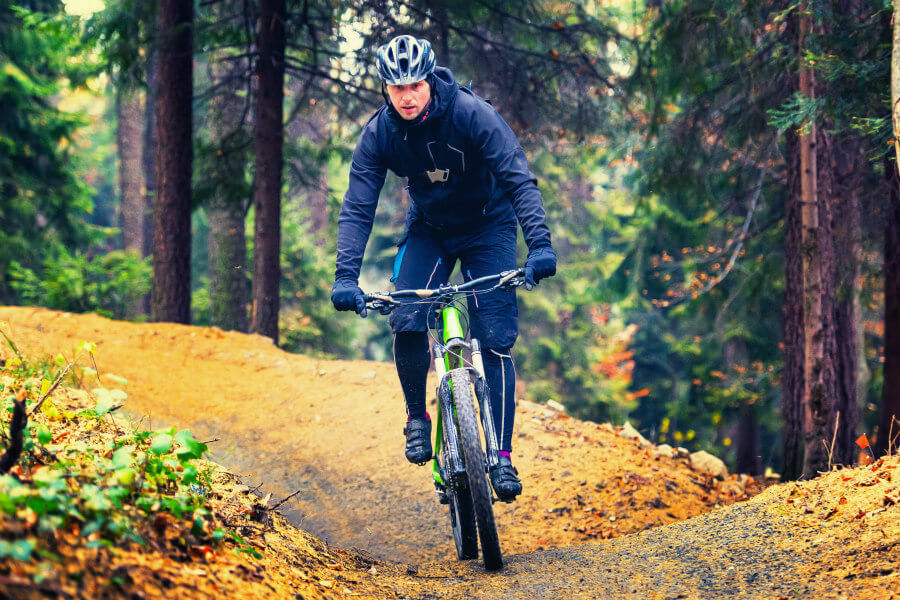
Let's be sincere: Of all the specific clothing garments to practice cycling, the long culote is one of the most uncomfortable. Pedaling for 3, 4 or 5 hours with covered knees is not pleasant.
However, if you live in an area where winter is not precisely soft and temperatures rarely rise from 5 degrees, the long culot is the best option.
There are different types of winter culotes depending on the climatic conditions for which they are designed. You can find them finer or faster, depending on the degree of isolation that they offer before the wind and its efficiency to maintain the temperature in the legs. In the end everything depends on whether you go by bicycle in a colder or another area, and on your level of tolerance to the sensation of cold in the legs.
Regardless of whether you choose a thinner or thicker long collection, it is important that it has a high degree of elasticity and seam Knee area. It is also important that the tissue is breathable, especially in the part that are in contact with the back, so that sweat does not accumulate and can evacuate well.
How to protect the feet from the cold
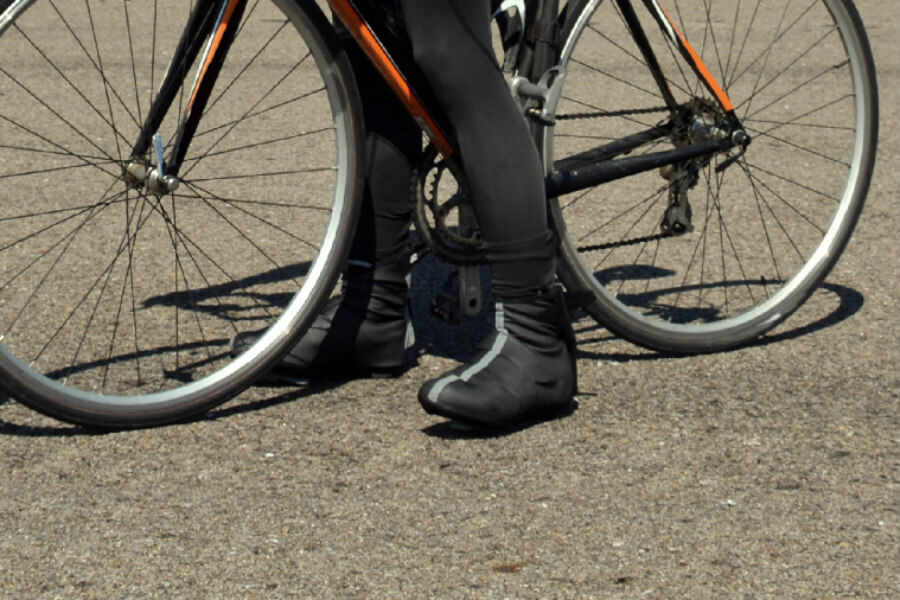
There are two parts of the body where the cold is noticed in a more intense way when we go by bicycle during the winter months: the hands and feet. The low temperatures can numb the fingers, which not only makes it difficult for us to continue pedaling, but also gives us a sense of suffering that is not necessary to suffer. Let's not forget that what we are about when we go by bicycle is to enjoy our favorite sport.
Neglecting the feet in winter can lead us to suffer an episode of partial freezing of the fingers or suffering from a pernium erythema, which is commonly known as sabañones. The hair vessels of the fingers are very sensitive to the cold and a continuous exposure to the wind or to the low temperatures causes them to become inflamed, which generates pain and limits the movements.
There are three basic cycling garments to protect the feet when we go by bicycle in winter:
- Socks
- The shoes or boots
- The covers
[IRP posts = "2770" name = "five things you should know about cycling socks"]
Just as we have short and long -sleeved mangots, and short and long culotes, there are also specific socks to use in winter. They are usually thicker and in some cases there are even waterproof, although the latter characteristic only has a real utility if we go out on bicycles in snowy areas or with high humidity.
Winter cycling socks have to fulfill a double function. The first is to isolate the skin from the outer cold, that is, that the feet are warm and we do not suffer numbness of the fingers by low temperatures. The second function is to keep the feet dry, so it is convenient for the tissue to be breathable so that it can evacuate sweat.
Is it necessary to have some winter shoes?
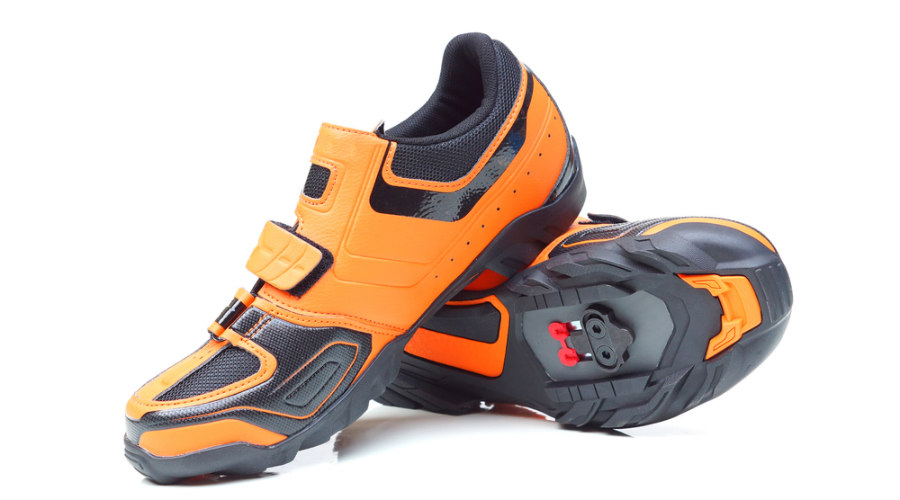
In addition to socks, in the market you can also find cycling shoes and Mountain Bike boots specific to use in winter. Is it advisable to have a couple? It depends on the cold you do in the area where you live and train and, especially, the type of cycling you practice.
If you go out a bicycle in an area where winters are soft and not excessively cold, it may be enough to put some shoes. This type of accessory is a kind of sock that is put above the boot to isolate it from the wind and moisture. In this way you can continue using the same footwear you carry in summer. In the road cyclimo, they also offer an aerodynamic advantage, although this will not be noted unless you are a competitor in long distance tests against the chrono.
If you practice mountain cycling, especially enduro, it is preferable to buy a winter shoes before a cover. Because? Because in mountain cycling the rubbing of the boots with arbutos and branches is frequent. In addition, in winter the paths, tracks and mountain roads are usually wet and accumulate puddles and mud. And we usually stand up to earth more frequently. This means that the covers ends up scratching or scratching in a few exits.
The boots of
Mountain Bike For winter they offer greater protection against impacts and friction. In addition, they are usually higher, covering to the ankle to better insulate the foot of possible water inlets.
But regardless of whether you practice mountain or route cycling, if you live in a cold winter zone, you most likely need specific footwear for this station. The explanation is simple: if your summer shoes or boots are very tight, you will not be able to wear thick socks. That is why it is common for some cyclists to wear one more sneaker in winter than they use during the rest of the year.
> See cycling shoes
Use of gloves for cycling in winter
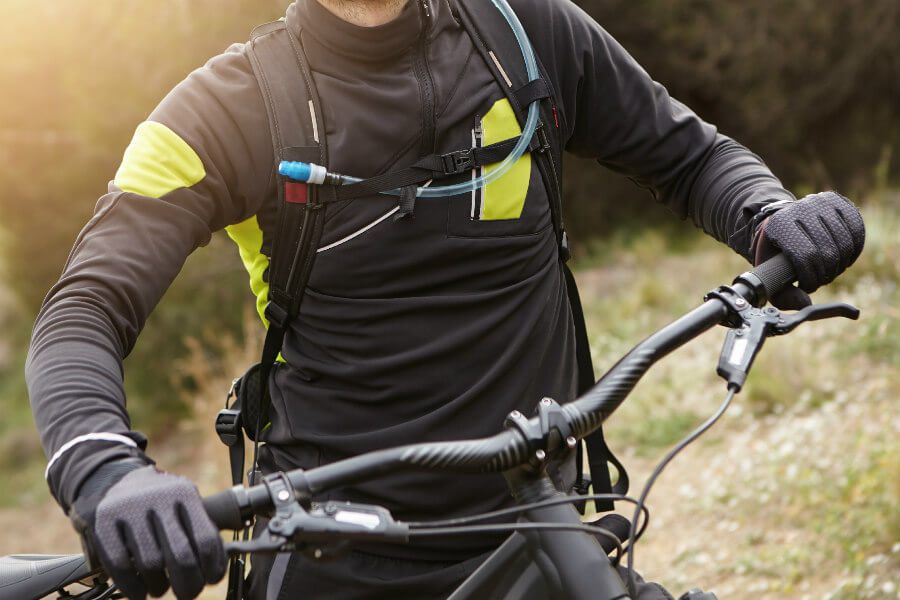
One of the most frequent discomforts that cyclists suffer when bicycle goes out during the winter months is that our fingers swell. The hands, like the feet, are very sensitive to cold. Hence the importance of wearing gloves.
If you go out to make short routes or in areas not excessively cold, fine basic gloves can be more than enough, although it is important that they are of breathable material so that the sweat does not accumulate. However, if you make long routes, more than 2 hours, or live in areas where winter thermometers do not rise from 5 or 6 degrees, it is advisable to wear thick gloves.
And it is important that they are
Specific cycling gloves. A frequent mistake is to wear mountain or wool gloves. Yes, mountaineering gloves are fat, protect from the wind and in case of rain are insulate from water. However, in cycling it is very important that any element that we carry in our hands guarantees us a good touch with the handles. That your finger is slipped when it stops or that costs you to act the change controls because the gloves you wear do not have a good grip can be the difference between finishing the route safely or suffering an unfortunate (and avoidable) accident.
How to protect the head
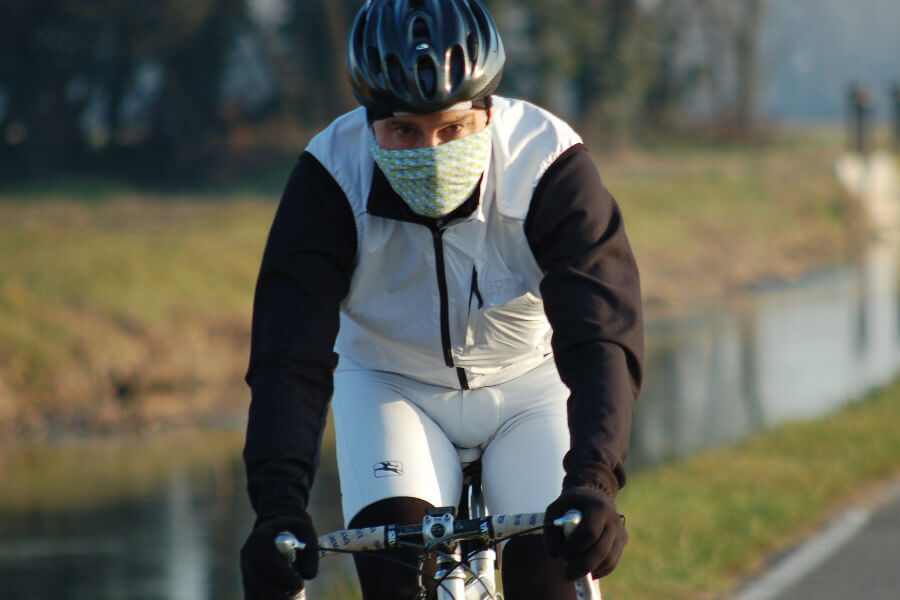
So far we have not commented, but it is necessary to say that whether winter or summer, make heat or cold, it rains or looks the sun, the helmet is a mandatory and essential accessory. With regard to this article, the market has not yet imposed the need to have a specific winter helmet. To protect the cold head there are other accessories and garments that perfectly fulfill this function. These are the ones we recommend:
Neck panties
The neck is an area of the body very sensitive to temperature changes. There are cyclists who prefer to go out to train or route with a naked neck due to a matter of sensations. However, it is important to protect the cold throat, water and wind. The best option is to buy a neck panties for cycling. There are different thicknesses, depending on the cold in the area where you usually bicycle. A fine panties will protect us from the wind, but what we want is to prevent the cold from heating in the throat, it is better to have two: one thin and one thicker. Do not buy it wool or cotton, because as Sudes will generate a sauna effect. The best thing, like any other cycling garment, is that it is of breathable tissue.
Winter's balaclavas, hats and badanas
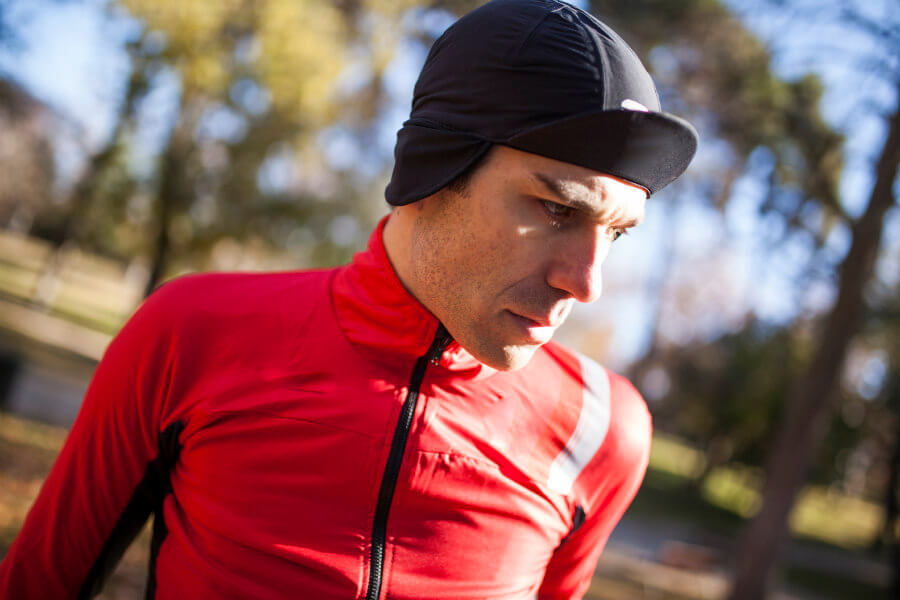
For days of intense cold, when the thermometer is approaching or low from zero degrees, a neck panties can be insufficient. In these circumstances you have two options:
- Put a hat for cycling along with the neck panties
- Put a balaclavas or sotoclasco
Winter's or badanas areolate the top of the cold head and in some cases also exert a waterproof function in case of rain. As for balaclavas, its advantage is that it completely covers both the head and the neck, so it avoids carrying other accessories such as panties or a tape to protect your ears. On the other hand, some cyclists find it very uncomfortable to wear their heads so covered.
Whether you prefer to wear balaclavas, hat or winter badana for the head, in no case these elements replace the helmet and it is recommended that they are not excessively thick precisely to be able to take them comfortably under the helmet.
Ears or head ribbons
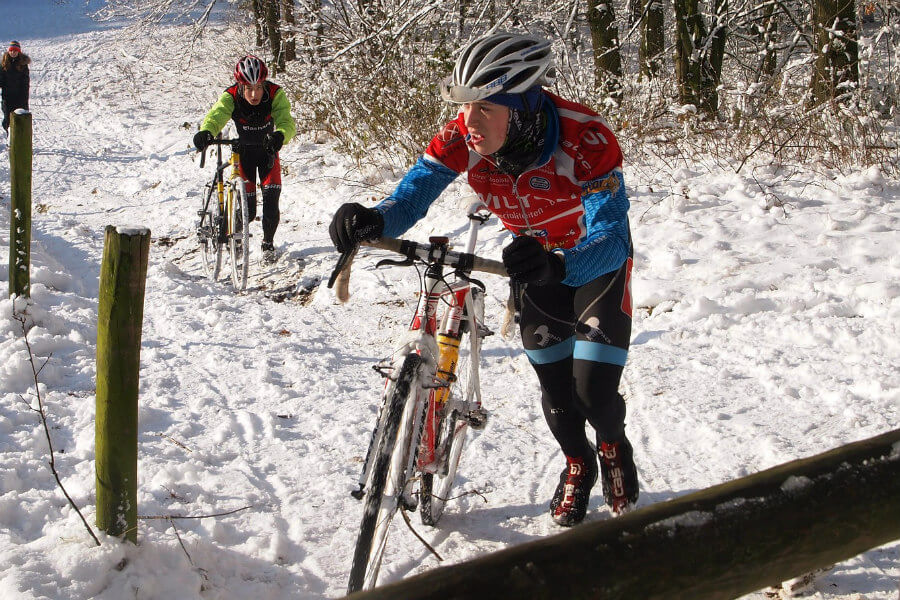
A part of the body that we often forgot to protect when we go by bicycle in winter are the ears. If air makes or the temperature is very low, the ears become a cold gate and the infections of both ear and throat that have their origin in practicing sports at low temperatures for a long time with the ears in the air are frequent .
With a balaclava you will take the covered ears. If you do not want to carry balaclava there are two recommended options:
- A winter cap with lateral extension for the ears.
- A wide head tape that covers the ears.
The head ribbons or cycling earmuffs have to be of fine textile material, to be able to put the helmet with meals. That is why it is not advisable to use ski earrings.
In situations of intense cold it can be advisable to buy a
Face Warmer or cycling mask for winter. It is an accessory that covers both ears and nose and mouth and makes it easier for us to breathe inside the mask to prevent the cold from entering the lungs. Some balaclañas have a function of
Face Warmer.
Other tips that you must take into account
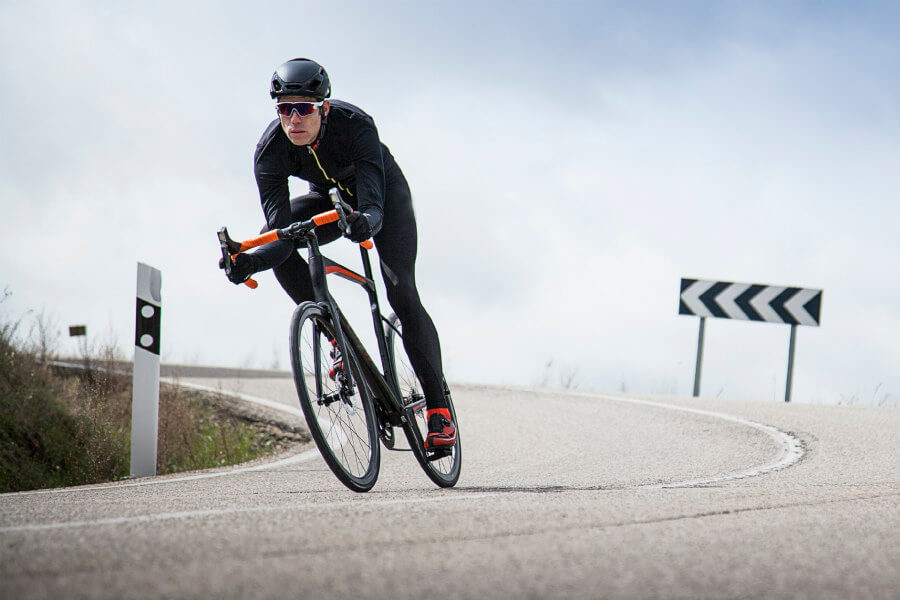
The main advice when buying winter clothes to practice cycling is that all garments are specific to this sport. Not only because of the functionality they offer, but because it will be more comfortable and practical to carry them in the backpack or in the jersey pocket in anticipation that time worsens.
We must not forget that we will be 2 to 5 hours on the middle of the bicycle and the climatic conditions can vary in this period of time. For example, if we leave very soon in the morning it will be colder than when we return and it is possible that we need to keep the jacket on the way back. When choosing what clothes to wear, do not be afraid to take any more garment in both the layers that you put in the body and in the pockets of the jersey. In winter it is always better to sinning heat than sinning cold and it is more optimal shivering cold.
Another detail that you should not lose sight of is that of colors. Winter cycling clothes are usually dark, since in this way more radiation is captured from the sun's rays. But it is always necessary that they have some reflective element or that some of the garments have striking colors, especially if you practice cycling en route. In winter the luminosity is less and dusk before. It is important that drivers can see us from afar.
Finally, is it necessary to always wear all the layers and garments with which you leave home? Roundly, no. The advantage of dressing on layers is that you can take the last one or add a new one depending on the thermal sensation you have, of the wind, of the rain or simply the moment of the route. For example, when you are very warm (thermal t -shirt, long jersey and jacket), many road cyclists open the jacket and jersey zippers when they climb a mountain port. What they are looking for with it is to avoid excessive sweating so as not to stay healdos during the descent.
 Really equipped to go by bicycle in the spring and summer months is relatively simple. It is enough with a fine and comfortable mail of short sleeve and a culot that does not make chafing.
But in winter the thing is complicated. The cold, the rain and the wind are not the best friends of the cyclist. Sometimes we can sin shortly when choosing the garments with which to go by bicycle, with the risk of contracting a cold. On other occasions we can also go from forecasts and suffer heat for wearing so many clothes on top.
[IRP posts = "3854" name = "How to prepare to go by bicycle in winter"]
How should we dress to go by bicycle during the winter months? Here are some guidelines that can be useful to equip your closet in order to continue enjoying the bicycle between November and February.
Really equipped to go by bicycle in the spring and summer months is relatively simple. It is enough with a fine and comfortable mail of short sleeve and a culot that does not make chafing.
But in winter the thing is complicated. The cold, the rain and the wind are not the best friends of the cyclist. Sometimes we can sin shortly when choosing the garments with which to go by bicycle, with the risk of contracting a cold. On other occasions we can also go from forecasts and suffer heat for wearing so many clothes on top.
[IRP posts = "3854" name = "How to prepare to go by bicycle in winter"]
How should we dress to go by bicycle during the winter months? Here are some guidelines that can be useful to equip your closet in order to continue enjoying the bicycle between November and February.
 It is important that the body remains at an adequate temperature. This is easy to understand: in winter it is cold and we need to be warm.
However, there is a detail that we should not forget. In winter we not only have to protect ourselves from low temperatures, but also from moisture. Both that can come from the outside through wind or rain, and from that generated inside through sweat.
Therefore, in addition to wearing clothes that isolate and warm, it is also very important that it is breathable and that allows sweat to evaporate from the body outward.
Just as in summer the logic dictates that we go out with a traditional manga jersey and traditional culotte, there are no specific clothing standards for winter. First because cold and humidity conditions are not the same in all places. And second because we are not all as sensitive to low temperatures.
However, there is a basic recommendation that we can follow to cover the body and protect ourselves from winter inclemencies: dress by layers. When choosing what garments to put on, it is recommended to wear three layers. rmally 3 layers.
The first layer helps us create a microclimate and move away the humidity produced by the sweat of the skin. The most advisable thing is to use a thermal shirt. It can be long -sleeved or short -sleeved, depending on how comfortable we feel with one or the other and the garment we use in the second layer.
The second layer fulfills the function of retaining heat and thus avoiding temperature loss. We can use a specific winter jersey or, if we wear a long -sleeved thermal t -shirt and does not make it excessive cold, the classic summer jersey.
The third layer aims to isolate ourselves from the cold, wind and humidity from outside. We can wear a vest, a specific jacket, a window or a raincoat.
It is important that the 3 layers are able to evaporate moisture from the inside, so the clothes must be breathable. Sweat is one of the worst enemies of cycling in winter, since we can be cold if too much moisture is concentrated near the skin.
[IRP posts = "3854" name = "How to prepare to go by bicycle in winter"]
It is important that the body remains at an adequate temperature. This is easy to understand: in winter it is cold and we need to be warm.
However, there is a detail that we should not forget. In winter we not only have to protect ourselves from low temperatures, but also from moisture. Both that can come from the outside through wind or rain, and from that generated inside through sweat.
Therefore, in addition to wearing clothes that isolate and warm, it is also very important that it is breathable and that allows sweat to evaporate from the body outward.
Just as in summer the logic dictates that we go out with a traditional manga jersey and traditional culotte, there are no specific clothing standards for winter. First because cold and humidity conditions are not the same in all places. And second because we are not all as sensitive to low temperatures.
However, there is a basic recommendation that we can follow to cover the body and protect ourselves from winter inclemencies: dress by layers. When choosing what garments to put on, it is recommended to wear three layers. rmally 3 layers.
The first layer helps us create a microclimate and move away the humidity produced by the sweat of the skin. The most advisable thing is to use a thermal shirt. It can be long -sleeved or short -sleeved, depending on how comfortable we feel with one or the other and the garment we use in the second layer.
The second layer fulfills the function of retaining heat and thus avoiding temperature loss. We can use a specific winter jersey or, if we wear a long -sleeved thermal t -shirt and does not make it excessive cold, the classic summer jersey.
The third layer aims to isolate ourselves from the cold, wind and humidity from outside. We can wear a vest, a specific jacket, a window or a raincoat.
It is important that the 3 layers are able to evaporate moisture from the inside, so the clothes must be breathable. Sweat is one of the worst enemies of cycling in winter, since we can be cold if too much moisture is concentrated near the skin.
[IRP posts = "3854" name = "How to prepare to go by bicycle in winter"]
 When buying clothes to wear when we go by bicycle during winter it is better not to focus on quantity, but on quality. It is not about buying a lot of clothes that shelter well, but about going out with the appropriate equipment so that we feel comfortable when we make a route or training.
It is better to acquire specific cycling clothes than multisport or other sports garments. A frequent error among fans who start in cycling is to wear jackets with neoprene or mountain to get out with the bicycle.
This clothes, although it is light and protects us from external cold and humidity, is actually designed to be used in conditions very different from pedaling on top of the bicycle. A hiker who ascends a mountain walking does not sweat the same as a cyclist who uploads a port or performs a trail route.
On the other hand, the thickness or the materials used fulfill a different function in the same garment depending on the sport for which it is designed. Neoprene, for example, is a good thermal insulator, but does not favor perspiration (except for goretex).
It should not forget that it is not just about not going cold. When you have been 3 hours on the bicycle, it is important to feel comfortable and not have the feeling that you are missing or you have any garment left over.
These are the basic garments that should not be missing in your closet if you are going out by bicycle during the winter months:
When buying clothes to wear when we go by bicycle during winter it is better not to focus on quantity, but on quality. It is not about buying a lot of clothes that shelter well, but about going out with the appropriate equipment so that we feel comfortable when we make a route or training.
It is better to acquire specific cycling clothes than multisport or other sports garments. A frequent error among fans who start in cycling is to wear jackets with neoprene or mountain to get out with the bicycle.
This clothes, although it is light and protects us from external cold and humidity, is actually designed to be used in conditions very different from pedaling on top of the bicycle. A hiker who ascends a mountain walking does not sweat the same as a cyclist who uploads a port or performs a trail route.
On the other hand, the thickness or the materials used fulfill a different function in the same garment depending on the sport for which it is designed. Neoprene, for example, is a good thermal insulator, but does not favor perspiration (except for goretex).
It should not forget that it is not just about not going cold. When you have been 3 hours on the bicycle, it is important to feel comfortable and not have the feeling that you are missing or you have any garment left over.
These are the basic garments that should not be missing in your closet if you are going out by bicycle during the winter months:
 It is, without a doubt, the essential garment that every cyclist should carry when it comes out in winter, regardless of the practice of route or mountain. The three qualities that a thermal t -shirt for cycling should have are: to perspire, that hot the body and that does not cause chafing.
The thermal shirt acts as a second skin. These t -shirts are usually elastic and it is convenient that they fit the body well. If you choose a size that will be large, bags will be generated between your skin and the shirt and may not fulfill its function. But do not forget that it is about fitting your skin, not what you compare you, so if you wear a small size you will go very tight and uncomfortable on top of the bicycle.
Maybe you can think that for this first layer you can serve an inner t -shirt of straps or short sleeves. It may protect you from the cold, but these types of t -shirts are usually made of cotton, a material that retains more humidity than the synthetic fibers of the thermal t -shirts. This means that sweat will not go abroad, with the consequent risk of moisture cooling.
It is advisable to have a fine and a thicker thermal shirt. Or a long sleeve and a short sleeve or technical t -t -shirt of straps. In this way you can combine them with the jersey depending on the cold it makes: the fine with a thicker jersey, or the thick long sleeve with the short -sleeved jersey. We insist: It is important that it be of quality, because it is in contact with our skin.
It is, without a doubt, the essential garment that every cyclist should carry when it comes out in winter, regardless of the practice of route or mountain. The three qualities that a thermal t -shirt for cycling should have are: to perspire, that hot the body and that does not cause chafing.
The thermal shirt acts as a second skin. These t -shirts are usually elastic and it is convenient that they fit the body well. If you choose a size that will be large, bags will be generated between your skin and the shirt and may not fulfill its function. But do not forget that it is about fitting your skin, not what you compare you, so if you wear a small size you will go very tight and uncomfortable on top of the bicycle.
Maybe you can think that for this first layer you can serve an inner t -shirt of straps or short sleeves. It may protect you from the cold, but these types of t -shirts are usually made of cotton, a material that retains more humidity than the synthetic fibers of the thermal t -shirts. This means that sweat will not go abroad, with the consequent risk of moisture cooling.
It is advisable to have a fine and a thicker thermal shirt. Or a long sleeve and a short sleeve or technical t -t -shirt of straps. In this way you can combine them with the jersey depending on the cold it makes: the fine with a thicker jersey, or the thick long sleeve with the short -sleeved jersey. We insist: It is important that it be of quality, because it is in contact with our skin.
 A recurring doubt to get in winter is the jersey. Is it better to buy a long -sleeved long -sleeved winter jersey or enough to acquire some sleeves and continue using the usual?
Here it will depend on each one, the sensations you have, the cold you feel, on the area where you go by bicycle. It is not the same to make a route in the month of January for the towns of black architecture inside Guadalajara at 8 degrees below zero than on the coast of Cádiz to 12 degrees.
The important thing is that it is a jersey. That is, it is a garment to make cycling, not an old sweater or a running sweatshirt.
Some cyclists prefer to wear fine jersey and sleeves to protect the arms. Others feel more comfortable with a long -sleeved thermal shirt under the short manga jersey. But most have a long -sleeved jersey, somewhat thicker for the days when the cold is more strongly. It never hurts to have a winter jersey in the closet.
A recurring doubt to get in winter is the jersey. Is it better to buy a long -sleeved long -sleeved winter jersey or enough to acquire some sleeves and continue using the usual?
Here it will depend on each one, the sensations you have, the cold you feel, on the area where you go by bicycle. It is not the same to make a route in the month of January for the towns of black architecture inside Guadalajara at 8 degrees below zero than on the coast of Cádiz to 12 degrees.
The important thing is that it is a jersey. That is, it is a garment to make cycling, not an old sweater or a running sweatshirt.
Some cyclists prefer to wear fine jersey and sleeves to protect the arms. Others feel more comfortable with a long -sleeved thermal shirt under the short manga jersey. But most have a long -sleeved jersey, somewhat thicker for the days when the cold is more strongly. It never hurts to have a winter jersey in the closet.
 The third layer is the one that generates the most when it comes to bicycle. Do we put the vest? Better a cycling jacket for winter? Do we take out the raincoat? When deciding to take into account a maxim that always applies: decide what you decide, more than once you will have the feeling that you have chosen badly.
Sometimes we sin excessively by putting the vest and the raincoat and ended up suffering a sauna effect while we climb a mountain port. On other occasions we leave the jacket at home because it seems that the sun is out and we end up missing it.
In the end everything will depend on the sensations you have and the time you do. If it rains or threatens rain, it never hurts to throw the raincoat or windwalk in the backpack. If she refreshes but the sky is clear and with a sun, it may be enough with the vest. If the thermometer marks temperatures below zero, the jacket is essential.
If you wear a vest, it is essential to wear sleeves unless you have a long -sleeved jersey or a long -sleeved thermal t -shirt.
In any case, this third layer of clothing is the easiest to add or remove. If you go in the middle of a route you should never stop to take off or wear a thermal shirt or a jersey. However, it is very easy to get a raincoat or a vest out of the pocket of the jersey. Or take off your jacket and save it in your backpack.
In winter the temperature usually vary from one week to another and even from one day to another. That is why it is advisable to have the three garments: vest, cycling jacket and raincoat. As with the thermal shirt and the jersey, buy material that is specific for cycling. A hunting raincoat or a neoprene jacket for mountaineering are not easy to store in the jersey pocket and hinder the evaporation of sweat.
The third layer is the one that generates the most when it comes to bicycle. Do we put the vest? Better a cycling jacket for winter? Do we take out the raincoat? When deciding to take into account a maxim that always applies: decide what you decide, more than once you will have the feeling that you have chosen badly.
Sometimes we sin excessively by putting the vest and the raincoat and ended up suffering a sauna effect while we climb a mountain port. On other occasions we leave the jacket at home because it seems that the sun is out and we end up missing it.
In the end everything will depend on the sensations you have and the time you do. If it rains or threatens rain, it never hurts to throw the raincoat or windwalk in the backpack. If she refreshes but the sky is clear and with a sun, it may be enough with the vest. If the thermometer marks temperatures below zero, the jacket is essential.
If you wear a vest, it is essential to wear sleeves unless you have a long -sleeved jersey or a long -sleeved thermal t -shirt.
In any case, this third layer of clothing is the easiest to add or remove. If you go in the middle of a route you should never stop to take off or wear a thermal shirt or a jersey. However, it is very easy to get a raincoat or a vest out of the pocket of the jersey. Or take off your jacket and save it in your backpack.
In winter the temperature usually vary from one week to another and even from one day to another. That is why it is advisable to have the three garments: vest, cycling jacket and raincoat. As with the thermal shirt and the jersey, buy material that is specific for cycling. A hunting raincoat or a neoprene jacket for mountaineering are not easy to store in the jersey pocket and hinder the evaporation of sweat.
 Once the body issue is resolved, let's go to the legs. Is it essential to use a long winter culot? Can you get by bicycle with the short culot and legs in the air? Is it better to invest in some perneras?
As with the top of the body, in terms of legs, two factors must be taken into account when buying specific clothing to practice cycling in winter.
On the one hand the climatic conditions that we are going to find in the two or three months of cold. If we live in Burgos and we want to leave an average of 2 or 3 days a week, we are probably profitable to spend money on a good winter long jersey. But if we live in Malaga or Huelva, we may only have one day throughout the winter where we will need it, so we can manage with quality perneras.
Our sensations are also important. As in the running, there are people who are really uncomfortable to play sports with long pants. In any case, keep in mind that the thermal sensation that is experienced in the legs when you have been over the bicycle with a short jersey in winter is not precisely pleasant.
Except that you live in an area where winters are soft and the temperature does not usually drop from 10 degrees, it is recommended to bike with the legs covered. The three most common ways to do so are the following:
Once the body issue is resolved, let's go to the legs. Is it essential to use a long winter culot? Can you get by bicycle with the short culot and legs in the air? Is it better to invest in some perneras?
As with the top of the body, in terms of legs, two factors must be taken into account when buying specific clothing to practice cycling in winter.
On the one hand the climatic conditions that we are going to find in the two or three months of cold. If we live in Burgos and we want to leave an average of 2 or 3 days a week, we are probably profitable to spend money on a good winter long jersey. But if we live in Malaga or Huelva, we may only have one day throughout the winter where we will need it, so we can manage with quality perneras.
Our sensations are also important. As in the running, there are people who are really uncomfortable to play sports with long pants. In any case, keep in mind that the thermal sensation that is experienced in the legs when you have been over the bicycle with a short jersey in winter is not precisely pleasant.
Except that you live in an area where winters are soft and the temperature does not usually drop from 10 degrees, it is recommended to bike with the legs covered. The three most common ways to do so are the following:
 In the same way that for the arms we can use sleeves, for the legs there are perneras, which can be complemented with knee heaters. The latter are a kind of knee that are adjusted in the joint.
An advantage of this option is that you do not need to buy a specific long winter jersey and it will be cheaper. However, it is important that the perneras are of quality to fit the leg comfortably without moving or excessively compressed. It is also important that they are of a specific material to practice cycling. If you use cotton perneras, sweat will not evaporate correctly. The sensation of pedaling with the legs soaked in sweat, especially in the rear of the knee, is not pleasant.
As a disadvantage, most perneras are designed to cover the skin, but not to completely isolate from the cold outside. That is, in the fresh days of autumn they are very practical, but in December at 3 degrees and with dry wind any of the following two options is preferable.
In the same way that for the arms we can use sleeves, for the legs there are perneras, which can be complemented with knee heaters. The latter are a kind of knee that are adjusted in the joint.
An advantage of this option is that you do not need to buy a specific long winter jersey and it will be cheaper. However, it is important that the perneras are of quality to fit the leg comfortably without moving or excessively compressed. It is also important that they are of a specific material to practice cycling. If you use cotton perneras, sweat will not evaporate correctly. The sensation of pedaling with the legs soaked in sweat, especially in the rear of the knee, is not pleasant.
As a disadvantage, most perneras are designed to cover the skin, but not to completely isolate from the cold outside. That is, in the fresh days of autumn they are very practical, but in December at 3 degrees and with dry wind any of the following two options is preferable.
 Like some cyclists, they prefer to wear a long -sleeved thermal shirt under the jersey, there are also those that choose to wear long meshes under the short culot.
As in the previous case, the main advantage is that we do not need to buy a long culot and we can continue to use the same short colotes that we dress in spring and summer. It will always be cheaper to acquire inner meshes than a winter culot.
This option can be more practical in winter than the use of perneras and/or knee heaters. However, like everything else, it is not exempt from disadvantages. The main one is comfort. When you make long routes or exits it is not recommended to wear under the culot to avoid the rubbing of the seams. If you put some meshes, no matter how thin they are, you are already adding a textile layer between your skin and the culot, so friction can occur. In addition, it is not practical in the event that you have to stop to go to the service.
Like some cyclists, they prefer to wear a long -sleeved thermal shirt under the jersey, there are also those that choose to wear long meshes under the short culot.
As in the previous case, the main advantage is that we do not need to buy a long culot and we can continue to use the same short colotes that we dress in spring and summer. It will always be cheaper to acquire inner meshes than a winter culot.
This option can be more practical in winter than the use of perneras and/or knee heaters. However, like everything else, it is not exempt from disadvantages. The main one is comfort. When you make long routes or exits it is not recommended to wear under the culot to avoid the rubbing of the seams. If you put some meshes, no matter how thin they are, you are already adding a textile layer between your skin and the culot, so friction can occur. In addition, it is not practical in the event that you have to stop to go to the service.
 Let's be sincere: Of all the specific clothing garments to practice cycling, the long culote is one of the most uncomfortable. Pedaling for 3, 4 or 5 hours with covered knees is not pleasant.
However, if you live in an area where winter is not precisely soft and temperatures rarely rise from 5 degrees, the long culot is the best option.
There are different types of winter culotes depending on the climatic conditions for which they are designed. You can find them finer or faster, depending on the degree of isolation that they offer before the wind and its efficiency to maintain the temperature in the legs. In the end everything depends on whether you go by bicycle in a colder or another area, and on your level of tolerance to the sensation of cold in the legs.
Regardless of whether you choose a thinner or thicker long collection, it is important that it has a high degree of elasticity and seam Knee area. It is also important that the tissue is breathable, especially in the part that are in contact with the back, so that sweat does not accumulate and can evacuate well.
Let's be sincere: Of all the specific clothing garments to practice cycling, the long culote is one of the most uncomfortable. Pedaling for 3, 4 or 5 hours with covered knees is not pleasant.
However, if you live in an area where winter is not precisely soft and temperatures rarely rise from 5 degrees, the long culot is the best option.
There are different types of winter culotes depending on the climatic conditions for which they are designed. You can find them finer or faster, depending on the degree of isolation that they offer before the wind and its efficiency to maintain the temperature in the legs. In the end everything depends on whether you go by bicycle in a colder or another area, and on your level of tolerance to the sensation of cold in the legs.
Regardless of whether you choose a thinner or thicker long collection, it is important that it has a high degree of elasticity and seam Knee area. It is also important that the tissue is breathable, especially in the part that are in contact with the back, so that sweat does not accumulate and can evacuate well.
 There are two parts of the body where the cold is noticed in a more intense way when we go by bicycle during the winter months: the hands and feet. The low temperatures can numb the fingers, which not only makes it difficult for us to continue pedaling, but also gives us a sense of suffering that is not necessary to suffer. Let's not forget that what we are about when we go by bicycle is to enjoy our favorite sport.
Neglecting the feet in winter can lead us to suffer an episode of partial freezing of the fingers or suffering from a pernium erythema, which is commonly known as sabañones. The hair vessels of the fingers are very sensitive to the cold and a continuous exposure to the wind or to the low temperatures causes them to become inflamed, which generates pain and limits the movements.
There are three basic cycling garments to protect the feet when we go by bicycle in winter:
There are two parts of the body where the cold is noticed in a more intense way when we go by bicycle during the winter months: the hands and feet. The low temperatures can numb the fingers, which not only makes it difficult for us to continue pedaling, but also gives us a sense of suffering that is not necessary to suffer. Let's not forget that what we are about when we go by bicycle is to enjoy our favorite sport.
Neglecting the feet in winter can lead us to suffer an episode of partial freezing of the fingers or suffering from a pernium erythema, which is commonly known as sabañones. The hair vessels of the fingers are very sensitive to the cold and a continuous exposure to the wind or to the low temperatures causes them to become inflamed, which generates pain and limits the movements.
There are three basic cycling garments to protect the feet when we go by bicycle in winter:
 In addition to socks, in the market you can also find cycling shoes and Mountain Bike boots specific to use in winter. Is it advisable to have a couple? It depends on the cold you do in the area where you live and train and, especially, the type of cycling you practice.
If you go out a bicycle in an area where winters are soft and not excessively cold, it may be enough to put some shoes. This type of accessory is a kind of sock that is put above the boot to isolate it from the wind and moisture. In this way you can continue using the same footwear you carry in summer. In the road cyclimo, they also offer an aerodynamic advantage, although this will not be noted unless you are a competitor in long distance tests against the chrono.
If you practice mountain cycling, especially enduro, it is preferable to buy a winter shoes before a cover. Because? Because in mountain cycling the rubbing of the boots with arbutos and branches is frequent. In addition, in winter the paths, tracks and mountain roads are usually wet and accumulate puddles and mud. And we usually stand up to earth more frequently. This means that the covers ends up scratching or scratching in a few exits.
The boots of Mountain Bike For winter they offer greater protection against impacts and friction. In addition, they are usually higher, covering to the ankle to better insulate the foot of possible water inlets.
But regardless of whether you practice mountain or route cycling, if you live in a cold winter zone, you most likely need specific footwear for this station. The explanation is simple: if your summer shoes or boots are very tight, you will not be able to wear thick socks. That is why it is common for some cyclists to wear one more sneaker in winter than they use during the rest of the year.
> See cycling shoes
In addition to socks, in the market you can also find cycling shoes and Mountain Bike boots specific to use in winter. Is it advisable to have a couple? It depends on the cold you do in the area where you live and train and, especially, the type of cycling you practice.
If you go out a bicycle in an area where winters are soft and not excessively cold, it may be enough to put some shoes. This type of accessory is a kind of sock that is put above the boot to isolate it from the wind and moisture. In this way you can continue using the same footwear you carry in summer. In the road cyclimo, they also offer an aerodynamic advantage, although this will not be noted unless you are a competitor in long distance tests against the chrono.
If you practice mountain cycling, especially enduro, it is preferable to buy a winter shoes before a cover. Because? Because in mountain cycling the rubbing of the boots with arbutos and branches is frequent. In addition, in winter the paths, tracks and mountain roads are usually wet and accumulate puddles and mud. And we usually stand up to earth more frequently. This means that the covers ends up scratching or scratching in a few exits.
The boots of Mountain Bike For winter they offer greater protection against impacts and friction. In addition, they are usually higher, covering to the ankle to better insulate the foot of possible water inlets.
But regardless of whether you practice mountain or route cycling, if you live in a cold winter zone, you most likely need specific footwear for this station. The explanation is simple: if your summer shoes or boots are very tight, you will not be able to wear thick socks. That is why it is common for some cyclists to wear one more sneaker in winter than they use during the rest of the year.
> See cycling shoes
 One of the most frequent discomforts that cyclists suffer when bicycle goes out during the winter months is that our fingers swell. The hands, like the feet, are very sensitive to cold. Hence the importance of wearing gloves.
If you go out to make short routes or in areas not excessively cold, fine basic gloves can be more than enough, although it is important that they are of breathable material so that the sweat does not accumulate. However, if you make long routes, more than 2 hours, or live in areas where winter thermometers do not rise from 5 or 6 degrees, it is advisable to wear thick gloves.
And it is important that they are Specific cycling gloves. A frequent mistake is to wear mountain or wool gloves. Yes, mountaineering gloves are fat, protect from the wind and in case of rain are insulate from water. However, in cycling it is very important that any element that we carry in our hands guarantees us a good touch with the handles. That your finger is slipped when it stops or that costs you to act the change controls because the gloves you wear do not have a good grip can be the difference between finishing the route safely or suffering an unfortunate (and avoidable) accident.
One of the most frequent discomforts that cyclists suffer when bicycle goes out during the winter months is that our fingers swell. The hands, like the feet, are very sensitive to cold. Hence the importance of wearing gloves.
If you go out to make short routes or in areas not excessively cold, fine basic gloves can be more than enough, although it is important that they are of breathable material so that the sweat does not accumulate. However, if you make long routes, more than 2 hours, or live in areas where winter thermometers do not rise from 5 or 6 degrees, it is advisable to wear thick gloves.
And it is important that they are Specific cycling gloves. A frequent mistake is to wear mountain or wool gloves. Yes, mountaineering gloves are fat, protect from the wind and in case of rain are insulate from water. However, in cycling it is very important that any element that we carry in our hands guarantees us a good touch with the handles. That your finger is slipped when it stops or that costs you to act the change controls because the gloves you wear do not have a good grip can be the difference between finishing the route safely or suffering an unfortunate (and avoidable) accident.
 So far we have not commented, but it is necessary to say that whether winter or summer, make heat or cold, it rains or looks the sun, the helmet is a mandatory and essential accessory. With regard to this article, the market has not yet imposed the need to have a specific winter helmet. To protect the cold head there are other accessories and garments that perfectly fulfill this function. These are the ones we recommend:
So far we have not commented, but it is necessary to say that whether winter or summer, make heat or cold, it rains or looks the sun, the helmet is a mandatory and essential accessory. With regard to this article, the market has not yet imposed the need to have a specific winter helmet. To protect the cold head there are other accessories and garments that perfectly fulfill this function. These are the ones we recommend:
 For days of intense cold, when the thermometer is approaching or low from zero degrees, a neck panties can be insufficient. In these circumstances you have two options:
For days of intense cold, when the thermometer is approaching or low from zero degrees, a neck panties can be insufficient. In these circumstances you have two options:
 A part of the body that we often forgot to protect when we go by bicycle in winter are the ears. If air makes or the temperature is very low, the ears become a cold gate and the infections of both ear and throat that have their origin in practicing sports at low temperatures for a long time with the ears in the air are frequent .
With a balaclava you will take the covered ears. If you do not want to carry balaclava there are two recommended options:
A part of the body that we often forgot to protect when we go by bicycle in winter are the ears. If air makes or the temperature is very low, the ears become a cold gate and the infections of both ear and throat that have their origin in practicing sports at low temperatures for a long time with the ears in the air are frequent .
With a balaclava you will take the covered ears. If you do not want to carry balaclava there are two recommended options:
 The main advice when buying winter clothes to practice cycling is that all garments are specific to this sport. Not only because of the functionality they offer, but because it will be more comfortable and practical to carry them in the backpack or in the jersey pocket in anticipation that time worsens.
We must not forget that we will be 2 to 5 hours on the middle of the bicycle and the climatic conditions can vary in this period of time. For example, if we leave very soon in the morning it will be colder than when we return and it is possible that we need to keep the jacket on the way back. When choosing what clothes to wear, do not be afraid to take any more garment in both the layers that you put in the body and in the pockets of the jersey. In winter it is always better to sinning heat than sinning cold and it is more optimal shivering cold.
Another detail that you should not lose sight of is that of colors. Winter cycling clothes are usually dark, since in this way more radiation is captured from the sun's rays. But it is always necessary that they have some reflective element or that some of the garments have striking colors, especially if you practice cycling en route. In winter the luminosity is less and dusk before. It is important that drivers can see us from afar.
Finally, is it necessary to always wear all the layers and garments with which you leave home? Roundly, no. The advantage of dressing on layers is that you can take the last one or add a new one depending on the thermal sensation you have, of the wind, of the rain or simply the moment of the route. For example, when you are very warm (thermal t -shirt, long jersey and jacket), many road cyclists open the jacket and jersey zippers when they climb a mountain port. What they are looking for with it is to avoid excessive sweating so as not to stay healdos during the descent.
The main advice when buying winter clothes to practice cycling is that all garments are specific to this sport. Not only because of the functionality they offer, but because it will be more comfortable and practical to carry them in the backpack or in the jersey pocket in anticipation that time worsens.
We must not forget that we will be 2 to 5 hours on the middle of the bicycle and the climatic conditions can vary in this period of time. For example, if we leave very soon in the morning it will be colder than when we return and it is possible that we need to keep the jacket on the way back. When choosing what clothes to wear, do not be afraid to take any more garment in both the layers that you put in the body and in the pockets of the jersey. In winter it is always better to sinning heat than sinning cold and it is more optimal shivering cold.
Another detail that you should not lose sight of is that of colors. Winter cycling clothes are usually dark, since in this way more radiation is captured from the sun's rays. But it is always necessary that they have some reflective element or that some of the garments have striking colors, especially if you practice cycling en route. In winter the luminosity is less and dusk before. It is important that drivers can see us from afar.
Finally, is it necessary to always wear all the layers and garments with which you leave home? Roundly, no. The advantage of dressing on layers is that you can take the last one or add a new one depending on the thermal sensation you have, of the wind, of the rain or simply the moment of the route. For example, when you are very warm (thermal t -shirt, long jersey and jacket), many road cyclists open the jacket and jersey zippers when they climb a mountain port. What they are looking for with it is to avoid excessive sweating so as not to stay healdos during the descent.












